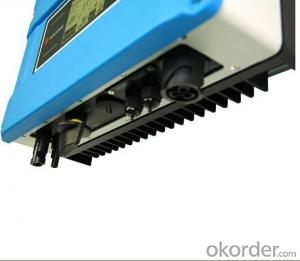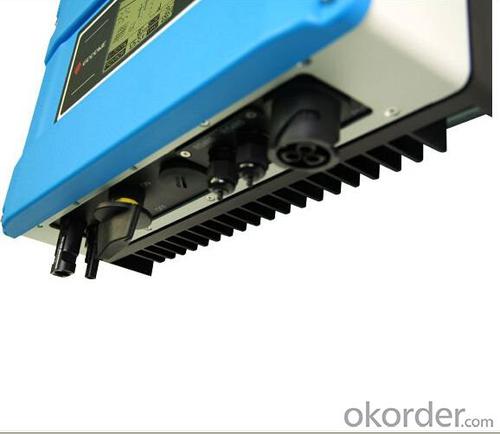House Solar Inverter GW3000-SS On Grid Solar Inverter
OKorder Service Pledge
OKorder Financial Service
You Might Also Like
GW3000-SS photovoltaic inverter is suitable for home rooftop photovoltaic system, designed under modern industrial concept. There are three colors for option with fashionable appearance. This model uses isolation-free design with advanced communication method and extremely high conversion efficiency. The maximum output power is 3000W. To ensure its stability and long service life, our inverter is manufactured with optimum quality components. It holds a safe lead among similar products.
Datasheet

- Q: Can a solar inverter be used with a solar-powered water pumping system?
- Yes, a solar inverter can be used with a solar-powered water pumping system. The solar inverter converts the direct current (DC) produced by the solar panels into alternating current (AC), which is necessary to power the water pump. By utilizing a solar inverter, the energy generated by the solar panels can be efficiently transferred to the water pumping system, allowing it to operate using clean and renewable energy.
- Q: Can a solar inverter be used in areas with frequent power outages?
- Yes, a solar inverter can be used in areas with frequent power outages. Solar inverters have the ability to convert the direct current (DC) power generated by solar panels into alternating current (AC) power that can be used to operate electrical devices. During power outages, the solar inverter can continue to provide electricity from the solar panels, allowing for uninterrupted power supply. However, it is important to note that a battery storage system may be required to store excess solar energy for use during periods of low sunlight or at night when the solar panels are not producing electricity.
- Q: Can a solar inverter be used with a solar-powered CCTV system?
- Yes, a solar inverter can be used with a solar-powered CCTV system. A solar inverter is responsible for converting the direct current (DC) produced by solar panels into alternating current (AC) that can be used to power electrical devices. In the case of a solar-powered CCTV system, the solar inverter can convert the DC power generated by the solar panels into the AC power required to run the CCTV system, ensuring it functions properly.
- Q: Can a solar inverter be used in areas with high levels of lightning activity?
- Yes, a solar inverter can be used in areas with high levels of lightning activity. However, it is important to ensure that the inverter is designed to withstand lightning strikes and has appropriate surge protection measures in place to prevent damage. Additionally, proper grounding and installation by a qualified professional are crucial to mitigate any potential risks associated with lightning strikes.
- Q: What is the role of a voltage regulation feature in a solar inverter?
- The role of a voltage regulation feature in a solar inverter is to ensure that the output voltage remains stable and within a specified range, regardless of fluctuations in the input voltage from the solar panels. This feature helps to protect the connected appliances and devices from damage due to overvoltage or undervoltage, and also optimizes the efficiency and performance of the solar inverter system.
- Q: How does the power factor correction affect the performance of a solar inverter?
- Power factor correction can significantly improve the performance of a solar inverter. By correcting the power factor, the inverter can optimize the energy conversion process, resulting in increased efficiency and reduced losses. This correction helps in minimizing reactive power, improving voltage stability, and enhancing the overall power quality of the inverter. Ultimately, power factor correction ensures that the solar inverter operates at its maximum capacity, leading to improved performance and increased energy output.
- Q: Can a solar inverter be used with a solar-powered water heating system?
- Yes, a solar inverter can be used with a solar-powered water heating system. The solar inverter converts the direct current (DC) generated by the solar panels into alternating current (AC) that can be used to power the water heating system. This allows for efficient utilization of solar energy and ensures the water heating system operates effectively.
- Q: How does a solar inverter affect the value of a property?
- A solar inverter can positively affect the value of a property by increasing its desirability and potential energy savings. It allows for the conversion of solar energy into usable electricity, reducing reliance on the grid and potentially lowering energy bills. Additionally, having a solar inverter in place can demonstrate a commitment to sustainability and environmental consciousness, which may be appealing to potential buyers and increase the property's overall value.
- Q: How does a solar inverter handle voltage flicker in the grid?
- A solar inverter handles voltage flicker in the grid by employing various control mechanisms. It continuously monitors the grid voltage and adjusts its own output accordingly to compensate for any fluctuations or flickering. By dynamically regulating its power output, the solar inverter helps stabilize the grid voltage and mitigate the impact of voltage flicker, ensuring a stable and reliable power supply.
- Q: What is the role of a solar inverter in anti-islanding protection?
- The role of a solar inverter in anti-islanding protection is to detect and prevent the occurrence of islanding. Islanding is a situation where a solar PV system continues to generate power and feed it into the grid during a power outage, which can pose a safety risk to utility workers attempting to restore power. The solar inverter monitors the grid voltage and frequency and when it detects an abnormality, such as a loss of grid connection, it quickly disconnects the PV system from the grid. This anti-islanding protection feature ensures that the solar system does not operate independently and helps maintain the safety and stability of the electrical grid.
Send your message to us
House Solar Inverter GW3000-SS On Grid Solar Inverter
OKorder Service Pledge
OKorder Financial Service
Similar products
Hot products
Hot Searches
Related keywords


























